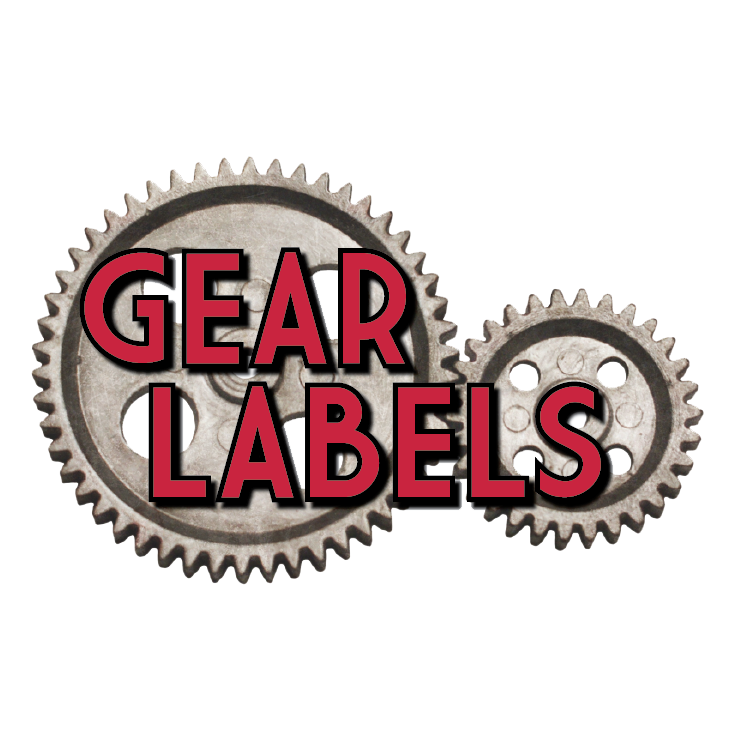FAQs
Where all the questions about the physical labels themselves are.
Be sure to keep scrolling!
Can you cut the label to [this size]?
YES.
Our printer is a cutter as well. The widest label we can make is 18.5 inches. Suffice it to say, we can likely cut to any size you want or need.
Note that it doesn’t have to be just circles, either. We have been replacing the labels on shaped inlaid chips from day one in 2014.
Laminated vs. Unlaminated. What’s the difference?
The difference between laminated and unlaminated labels is what happens after the labels are printed.
All of our labels are printed on adhesive-backed vinyl. After printing, an additional layer of adhesive-backed protective film can optionally be applied (i.e. laminated) on top of the printed surface.
This adds thickness as well as improving the look, the feel, and even the sound once they are applied to a chip. We print on glossy vinyl when making labels that are going to be laminated, so that the laminate adheres a bit better and the graphics are as clear as possible through the laminate itself.
Perhaps obviously, unlaminated labels are applied to the chip without an additional protective layer, which keeps the overall thickness to a minimum. The inks are still waterproof and relatively resistant to wear. Of course, you can always scratch something if you try hard enough, but under normal use they hold up just fine.
We print on matte vinyl for unlaminated labels, to keep the glare down to a minimum. (Unlaminated glossy labels tend to look a bit cheap -- think “bumper sticker”.)
Laminated vs. Unlaminated. What is the use case?
Unlaminated labels are very good, but are really only intended for applying over the existing inlays on casino-grade chips (e.g. Paulsons) because they are thinner. Laminated labels are generally always preferable to unlaminated labels — as mentioned, they give the chips a better look, a better feel, and even a better sound — but they are not recommended for applying over existing inlays. The additional thickness risks creating spinners and other stacking / handling issues.
If you are removing the existing inlays or labels from your chips and replacing them with labels, you should always use laminated labels. This goes for any type of chip: Paulson casino chips, china clays such as Milanos, Majestics, Royals, or anything else.
One difference in usage between laminated and unlaminated labels is their typical final-cut size. For example, unlaminated labels intended for Paulson casino chips are sized to fill the entire inlay recess on the face of the chip. Note that this is larger than the factory inlay! On most Paulson chips, there is a region of "blank" chip between the inlay and the edge of the inlay recess. While it's certainly possible to print (or leave unprinted, for a white label) the entire label area, it looks much better to mimic the border of “blank” chip with a printed outer edge matching the base color of the chip.
Which one should I choose and why?
Deciding which road you want to go down is a matter of personal preference and circumstance. Ultimately it is up to you, and we won’t recommend one over the other unless there is a specific reason.
This forum thread has a lot of knowledgeable people discussing the pros & cons and the whys and why nots.
Which laminate should I use?
We offer several laminates:
Smooth has a satin finish with no texture.
recommended for inlay replacement on Paulson RHC, or when matching other sets with existing smooth labels.
Matte has a satin finish with a slight texture.
the most similar to china clay labels, e.g. Majestic or Milano. Recommended when adding labels to those chips.
Also recommended when replacing inlays on somewhat used Paulson THC chips (i.e. with worn cross-hatching.)
Textured has a satin finish with a lot of texture, similar to cross-hatching on Paulson or CPC chips.
recommended when replacing inlays on CPC/ASM chips on the HHR mold, or other molds with cross-hatching in the label area.
also recommended when replacing inlays on new Paulson THC chips, or adding labels to milled hotstamped Paulsons or TRK chips.
Glossy has a shiny finish with no texture (smooth and clear.)
recommended when matching chips with particularly glossy/shiny labels. Can be a good match for CPC chips on the FDL mold, or other smooth CPC molds.
Thick/glossy has a very shiny finish with no texture, and is substantially thicker than the other laminates.
recommended only for Bud Jones-style chips, or SunFly ceramic hybrids. Possibly also CPC chips on the FDL mold. Not appropriate for Paulsons.
Thick/matte has a satin finish with no texture, and is substantially thicker than the other laminates.
recommended only for Bud Jones-style chips, Matsuis or SunFly ceramic hybrids. Possibly also CPC chips on the FDL mold. Not appropriate for Paulsons.
Unlaminated labels are printed on matte vinyl, to minimize glare.
recommended when putting labels on top of existing inlays without removing them, e.g. casino Paulsons
not recommended for labelling any blank chips. Blank chips with a recess should always get a laminated label. Blank chips with no recess should not be labelled without being milled first.
What do you mean by “satin finish”?
Satin means semi-gloss. It's not completely matte/flat/dull, but it's not as shiny and reflective as a glossy finish.
We also have sample kits on our products and services page. Be sure to scroll down to see our recommendations for getting the most out of your samples.
Can you make a label look like a hot stamp?
Not really, no.
The feel would be wrong, as there wouldn’t be any texture.
We can’t print metallic that looks anything close to actual foil.
If you’re thinking “What about a clear label?” we thought that too, but when we tried it, it sucked. You could see the adhesive and ALL the imperfections.
How to I remove the labels from my chips?
In a word… Carefully.
PCF (the Poker Chip Forum) has a lengthy and detailed thread on to this subject. (Well, several threads, really.) If you don’t want to pay us to remove and replace inlays, this is where your rabbit hole begins.
Someone out there started referring to inlay removal or hotstamp milling as “Chip Murder” a term which we don’t hate, but we don’t love either.
Do us all a favor, and please call it inlay removal or inlay replacement or similar, in all your communications with us.
I wouldn’t blame the authorities for wanting to speak to us about why people keep emailing us to ask to “murder” something. Or funner yet, people asking for help after the fact. Not a conversation we want to have.
To the overwatchers who care to look, here is the explanation. Thanks!
How do I apply the labels to my chips?
Surprisingly gently.
The only tool we have on hand when labelling is an exacto blade.
It’s OK to use your fingers to pull the label from its backing.
We find the adhesive is strong enough to handle a few finger prints (but always wash your hands first.)
Chris actually pulls 4-6 off at a time and sticks them to the back of his other hand as a hopper/queue!
Hold it like a coin, by its edges.
Squeeze the label the slightest amount, like the start of making a taco.
This gives us a nice point to focus on.
Then line that point up with the edge of the inlay area. Try to get it right to the edge, but don’t jam it over there as hard as it will go.
When it looks centered, let go and let the label drop into the recess.
DO NOT PRESS DOWN YET.
If the label needs adjustment, take the exacto blade and put it under an edge and maneuver for better position. (If needed, you could take the label off completely at this time and re-position it.)
Once you’re satisfied with the position, use your thumb to lightly press the label in to make sure there is good adhesion. It is not necessary to smash the label down into next week.
Generally, we recommend against heavily burnishing your labels to the chips. In our experience that can lead to a lumpy result, and we just don’t like the look.
We find there are always flaws in that inlay area, and the harder you press the label down on it, the more they will show up.
The adhesive on these labels will hold just fine with a circular sweep of the thumb with a bit of pressure.
Why are my labels too small? Did they shrink?
Chances are you got your labels a while back and didn’t get a chance to put them on your chips right away. This phenomenon is not limited to just our labels.
All labels, (not just ours) purchased on the secondary market, are little circles cut out of large sheets of stretchy vinyl that are 20" to 40” wide and over a hundred feet long. The backing this vinyl is put on gives little to no resistance, to ensure easy removal. This means there is nothing to resist the very stretchy vinyl from contracting/shrinking in size, since there isn't a wide spread out force holding it on the backing.
Once the labels are applied to the chip, this is no longer a major issue. The adhesive against the hard surface of the chip is enough resistance to prevent shrinkage for both laminated and unlaminated labels alike.
The longer your labels stay on the sheets and not applied to the chips, the more likely it is the size of the label will be smaller than expected or desired.
The matte unlaminated labels experience this the most, and the fastest.














